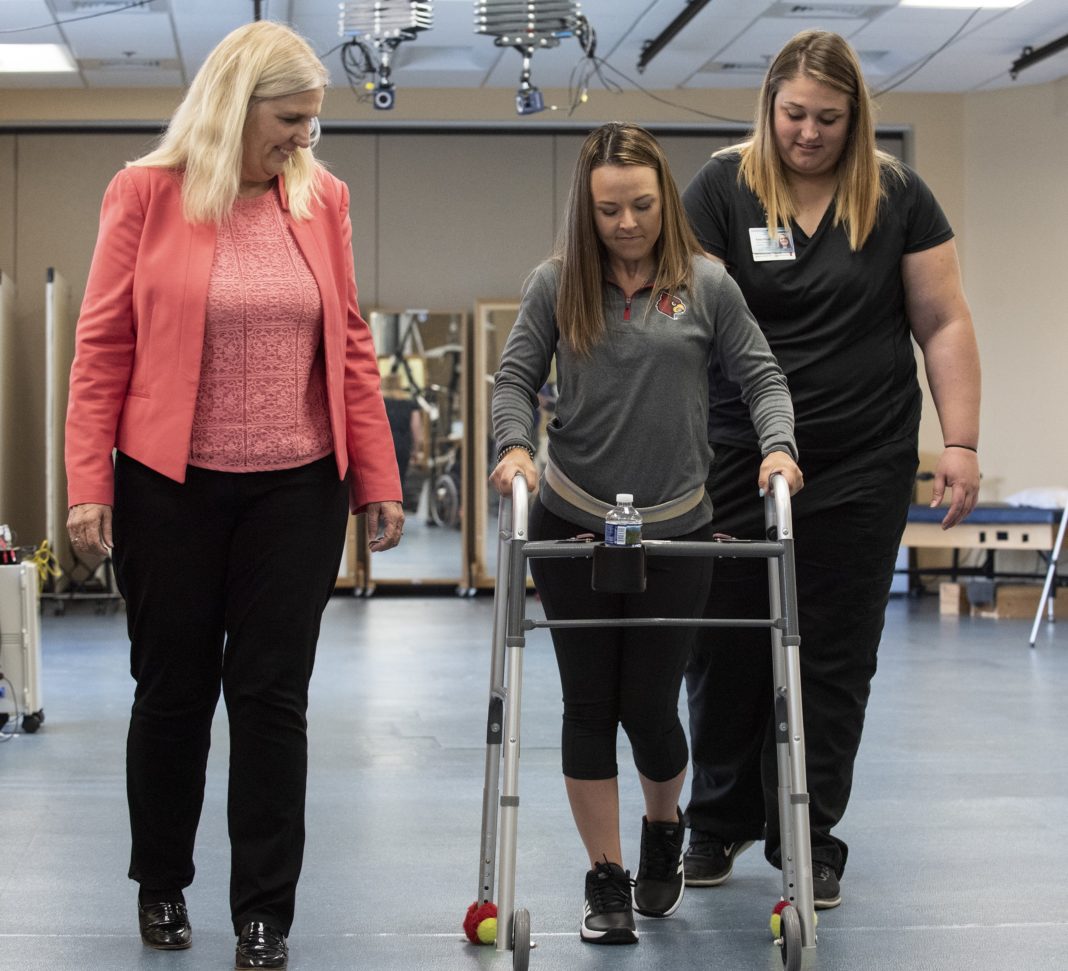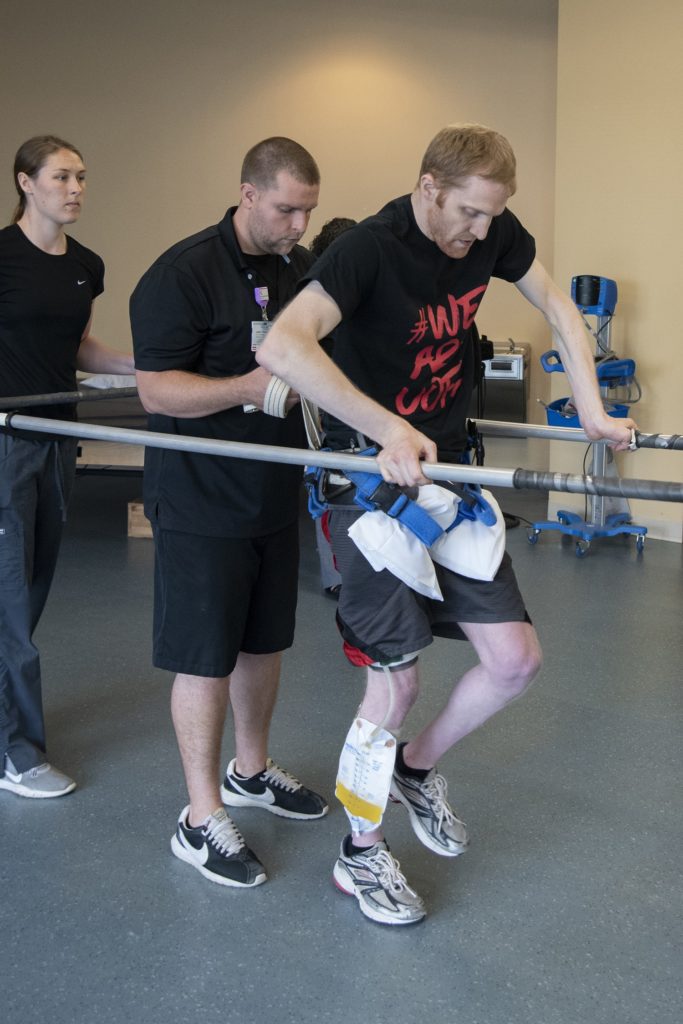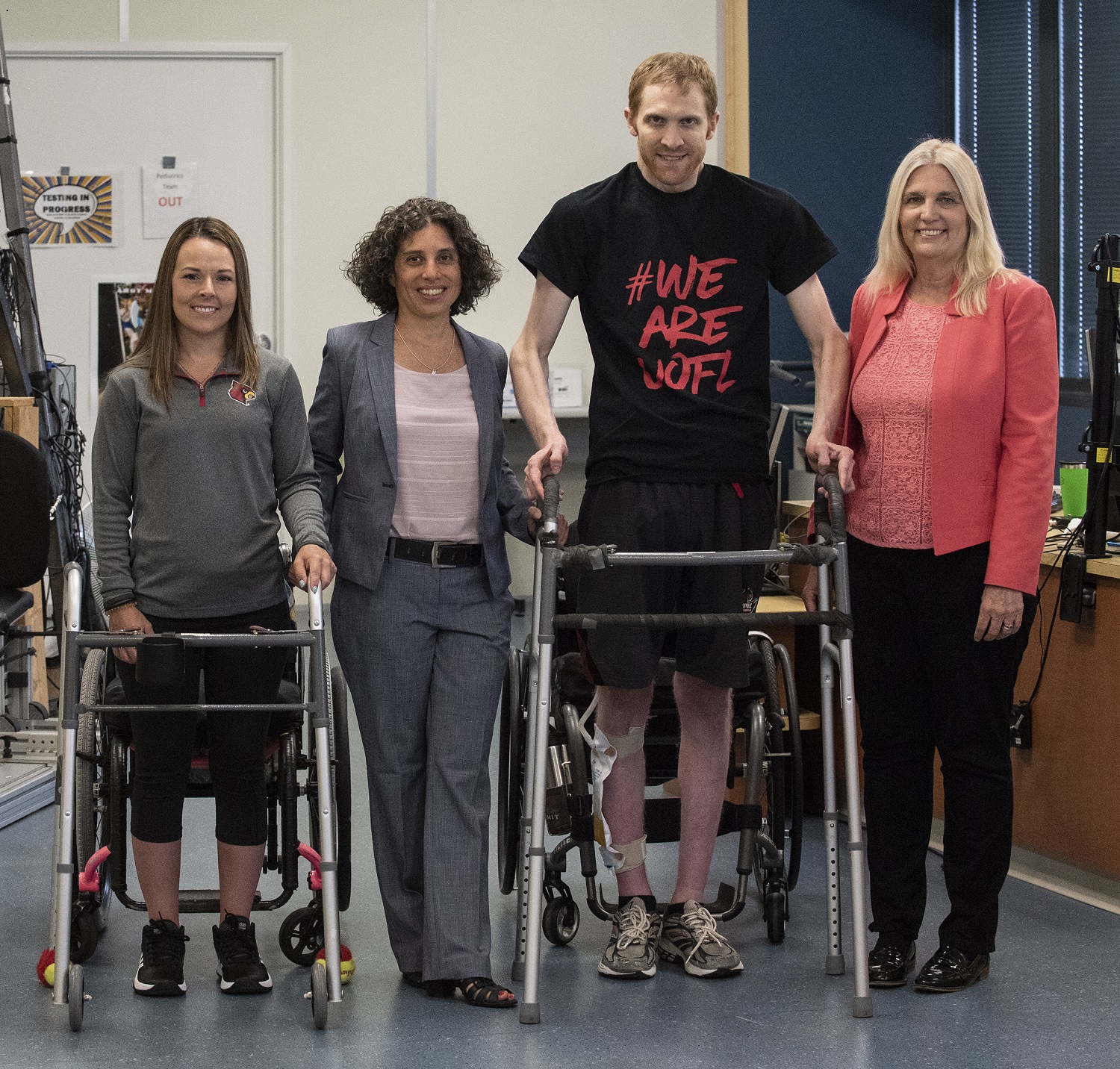
New research published in the New England Journal of Medicine documents the effectiveness of epidural stimulation with locomotor training following chronic, complete spinal cord injury in restoring brain-to-spine connectivity, long thought to be impossible
EDITOR’S NOTE: Download video story, broadcast quality b-roll and sound bites for this story at the links. Additional photos also are available on request.
LOUISVILLE, Ky. – Of four research participants living with traumatic, motor complete spinal cord injury, two are able to walk over ground with epidural stimulation following epidural stimulation paired with daily locomotor training. In addition, all four participants achieved independent standing and trunk stability when using the stimulation and maintaining their mental focus. The study was conducted at the Kentucky Spinal Cord Injury Research Center at the University of Louisville (UofL) and was published online early, and will appear in the Sept. 27 issue of New England Journal of Medicine. The study was funded by the Leona M. and Harry B. Helmsley Charitable Trust, University of Louisville Hospital and Medtronic plc.
This ground-breaking progress is the newest development in a string of outcomes at UofL, all pointing to the potential of technology in improving quality of life – and even recovery – following spinal cord injury. This latest study builds on initial research published in The Lancet in 2011 that documented the success of the first epidural stimulation participant, Rob Summers, who recovered a number of motor functions as a result of the intervention. Three years later, a study published in the medical journal Brain discussed how epidural stimulation of the spinal cord allowed Summers and three other young men who had been paralyzed for years to move their legs. Later research from UofL demonstrated this technology improved blood pressure regulation.
“This research demonstrates that some brain-to-spine connectivity may be restored years after a spinal cord injury as these participants living with motor complete paralysis were able to walk, stand, regain trunk mobility and recover a number of motor functions without physical assistance when using the epidural stimulator and maintaining focus to take steps,” said author Susan Harkema, Ph.D., professor and associate director of the Kentucky Spinal Cord Injury Research Center at the University of Louisville. “We must expand this research – hopefully, with improved stimulator technology – to more participants to realize the full potential of the progress we’re seeing in the lab, as the potential this provides for the 1.2 million people living with paralysis from a spinal cord injury is tremendous.”
Progress for Individuals Living with Paralysis
The American Spinal Injury Association Impairment Scale (AIS) was used to classify the spinal cord injuries of each of the four participants. When the four participants joined the study, they were at least 2.5 years post injury. They were unable to stand, walk or voluntarily move their legs. Eight to nine weeks prior to the implantation of an epidural stimulator, they started daily locomotor training – manual facilitation of stepping on a treadmill – five days per week for two hours each day. Although there were no changes to their locomotor abilities prior to the implant, following the epidural stimulation participants were able to step when the stimulator was on and the individual intended to walk. Participants 3 and 4 were able to achieve walking over ground – in addition to on a treadmill – with assistive devices, such as a walker and horizontal poles for balance while the stimulator was on.
“Being a participant in this study truly changed my life, as it has provided me with a hope that I didn’t think was possible after my car accident,” said Kelly Thomas, a 23-year-old from Florida, also referred to as Participant 4. “The first day I took steps on my own was an emotional milestone in my recovery that I’ll never forget as one minute I was walking with the trainer’s assistance and, while they stopped, I continued walking on my own. It’s amazing what the human body can accomplish with help from research and technology.”

Jeff Marquis, a 35-year-old Wisconsin native who now lives in Louisville, was the first participant in this study to attain bilateral steps. “The first steps after my mountain biking accident were such a surprise, and I am thrilled to have progressed by continuing to take more steps each day. In addition, my endurance has improved, as I’ve regained strength and the independence to do things I used to take for granted like cooking and cleaning,” said Marquis, who is participant 3 in New England Journal of Medicine study. “My main priority is to be a participant in this research and further the findings, as what the University of Louisville team does each day is instrumental for the millions of individuals living with paralysis from a spinal cord injury.”
“While more clinical research must be done with larger cohorts, these findings confirm that the spinal cord has the capacity to recover the ability to walk with the right combination of epidural stimulation, daily training and the intent to step independently with each footstep,” said Claudia Angeli, Ph.D., senior researcher, Human Locomotor Research Center at Frazier Rehab Institute, and assistant professor, University of Louisville’s Kentucky Spinal Cord Injury Research Center.
Advancements for Spinal Cord Injury Community
This research is based on two distinct treatments: epidural stimulation of the spinal cord and locomotor training. Epidural stimulation is the application of continuous electrical current at varying frequencies and intensities to specific locations on the lumbosacral spinal cord. This location corresponds to the dense neural networks that largely control movement of the hips, knees, ankles and toes. Locomotor training aims to ultimately retrain the spinal cord to “remember” the pattern of walking by repetitively practicing standing and stepping. In a locomotor training therapy session, the participant’s body weight is supported in a harness while specially trained staff move his or her legs to simulate walking while on a treadmill.
“We are seeing increasing interest in the use of neuromodulation procedures and technologies such as epidural stimulation in the treatment of spinal cord injury and restoration of locomotor, cardiovascular and urodynamic functions,” said Maxwell Boakye, M.D., M.P.H., M.B.A., chief of spinal neurosurgery at the University of Louisville and clinical director of the Kentucky Spinal Cord Injury Research Center. “Epidural stimulation is likely to become a standard treatment with several improvements in design of the device to target more specific neurological circuits.”
For more information on epidural stimulation research, visit Victoryoverparalysis.org.
#WeAreUofL

Bibliographic details:
“Recovery of Walking Overground after Chronic Motor Complete Spinal Cord Injury” by Claudia A. Angeli, Ph.D., Maxwell Boakye, M.D., Rebekah A. Morton, B.S., Justin Vogt, B.S., Kristin Benton, B.S., Yangshen Chen, Ph.D., Christie K. Ferreira, B.S. and Susan J. Harkema, Ph.D.
New England Journal of Medicine DOI: 10.1056/NEJMoa1803588
The University of Louisville (UofL) School of Medicine
The University of Louisville School of Medicine, founded in 1837, is one of the oldest medical schools in the United States. On its metropolitan Health Sciences Center campus, more than 600 medical students, 275 graduate students, and 1,000 resident physicians and post-doctoral fellows train each year with approximately 900 faculty members in 5 basic science and 18 clinical science departments. Researchers at UofL are using stem cells to regrow damaged heart muscle, investigating new cancer treatments, and improving therapies for spinal cord injuries, among many areas of clinical and basic research. In addition to teaching and research, faculty members see patients at facilities throughout the city, including the Ambulatory Care Building, the UofL Physicians Outpatient Center, the James Graham Brown Cancer Center, University of Louisville Hospital, the primary adult teaching hospital for the School of Medicine, Norton Children’s Hospital, the pediatric teaching hospital for the school, and the Novak Center for Children’s Health, opened in July 2018.
The Kentucky Spinal Cord Injury Research Center (KSCIRC) at the University of Louisville (UofL)
The Kentucky Spinal Cord Injury Research Center (KSCIRC), opened in 2001, provides the opportunity for basic scientists, physicians, neurosurgeons and physical therapists to work collaboratively with the common goal of curing paralysis. Through close association with clinical colleagues in the UofL Department of Neurological Surgery, KSCIRC is in a unique position to conduct research designed ultimately to lead to effective treatments for spinal cord injury. This continuum of research has facilitated a “bench-to-bedside” and “bedside-to-bench” approach, where basic science questions are examined from a translational perspective, and findings in the clinical setting enlighten or guide future basic scientific studies.
Research at KSCIRC using activity-based training and spinal cord epidural stimulation (scES) – electrical signals delivered to motor neurons in the spine by an implanted device – has allowed research participants to stand, step and perform relatively fine voluntary lower limb movements, and have resulted in improvements in blood pressure regulation and bladder, bowel and sexual function.
Activity-based training involves locomotor training, stepping on a treadmill with body weight supported, and stand training in a specially designed frame.



























